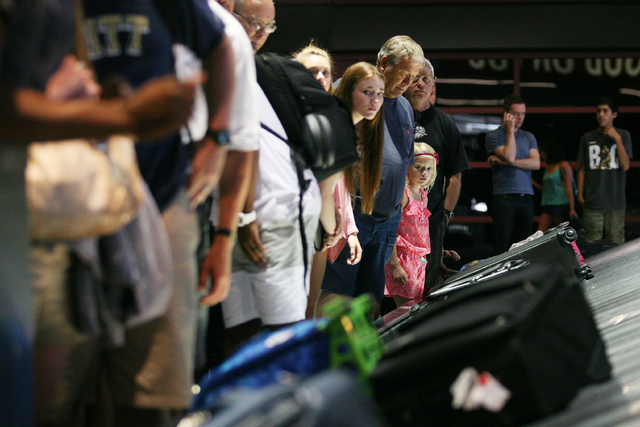Win the battle of baggage fees

Baggage — that sprawling collection of carry-ons, checked suitcases, purses and briefcases that we cart around with us while getting from here to there — has become a complicated, sometimes expensive aspect of commercial air travel.
That’s because, in contrast to the days not so long ago when travelers could pack pretty much everything they wanted into a few suitcases, today’s fliers have to keep in mind suitcase size and weight limits and restrictions on the number of bags they can check, pay a fee for checking even a single bag, pay (at a few airlines) a fee to carry a bag on board the plane, and pay significant penalty fees for bags that weigh too much.
But successfully navigating this maze of baggage-related concerns is possible if travelers keep a few basics in mind.
First, about those checked baggage fees: While it’s a trend most travelers hate, it’s one that’s continuing. These days, many airlines, including major carriers, have established fees beyond the price of a ticket — $25 for the first bag seems to be a common starting point — for every bag a passenger checks.
And if that trend wasn’t annoying enough, Maria Lilibeth Ruiz, director of marketing for Prestige Travel and Cruises American Express, notes that a few discount carriers charge fees for carry-on bags, too. An airline even may have one fee for stowing a bag in the overhead compartment and another for stowing it under the seat, she adds, “and it can run up to like $40 per item.”
Baggage fees can turn what had seemed like a great fare into a not-as-great fare. That’s why Rene Schneeberger, travel agency manager for AAA Northern California, Nevada and Utah, recommends that, when comparing fares, travelers add into the bottom-line prices the baggage fees each airline charges.
Only then, he says, can the traveler “compare what the full trip is going to cost you.”
Airlines’ websites usually outline carriers’ baggage policies (including how many checked and carry-on items are permitted for each passenger) as well as fee schedules for checked and carry-on bags, although finding the info sometimes can be “a bit of a challenge,” Schneeberger says.
Don’t forget to double the fares you see when booking round-trips and to include baggage fees for every traveler in the family. Ruiz also suggests that travelers consider paying baggage fees online, in advance of the trip, because baggage fees paid at the airport on the day of the trip may be higher.
The bottom line is that “you really need to compare the (total) cost of the trip,” Schneeberger says, because baggage fees “can very easily make a $100 difference” in the cost of a ticket.
“Most carriers now charge $50 or $25 for the first bag and $75 for the second, and it all depends on their own rules,” he says, so, sometimes, “a fare may no longer be the lowest in the market when you compare apples to apples.”
Travelers who want to avoid paying baggage fees still have a few options. Schneeberger notes that a few carriers don’t charge baggage fees. Southwest Airlines, for example, allows two free checked bags per passenger.
Another possibility is to use an airline’s own branded credit card to pay for your trip. Such cards typically offer a few perks to travelers, including free checked bags.
“While we’re not an advocate of acquiring credit cards, one way airlines have found to create value is getting you to sign up for their frequent-flier Visa or MasterCards, and many of these cards have free bag benefits,” Schneeberger says.
“For someone who travels once a year, it’s probably not worth it. But if you travel two or three times a year to visit family, it makes sense to stick with the same airline and get benefits included in the cards.”
Finally, there’s this admittedly sneaky strategy: If you have a carry-on bag that you won’t need during the flight, avoid the hassle of finding an empty overhead bin on-board by asking the gate agent to check it for you. There’s no guarantee, Schneeberger says, but you probably won’t have to pay the usual checked bag fee for a bag checked at the gate.
Of course, the bag still would have to conform to carry-on dimension requirements and still would have to be able to pass through security checkpoints, with all of the requirements that entails.
But, Schneeberger explains, airlines are keen on doing whatever they can to speed up the boarding process and minimizing the number of bags that have to be stowed in overhead compartments or under seats helps toward that end.
Read more from John Przybys at reviewjournal.com. Contact him at jprzybys@reviewjournal.com and follow @JJPrzybys on Twitter.